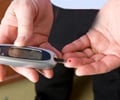Scientists at the University of California in Los Angeles have devised an easier approach to detect excess glucose in the body.
Laurent Pilon and Kamal Katika have found that glucose reacts with proteins in body tissues such as the skin and blood vessels to produce a set of chemicals called advanced glycation end-products.AGE products tend to accumulate in the walls of blood vessels causing them to become thicker and more rigid, which is one of the complications of diabetes.
During experiments, the scientists found that AGE products fluoresce when zapped with light - the greater their concentration, the more fluorescence they produce.
The duo has now proposed a device that beams a series of short pulses onto the skin and measures the amount of fluorescence produced by any AGE products.
According to New Scientist, the fluorescence would not only allow diabetes to be diagnosed, but also give an idea of how advanced it has become.
The researchers say their method is much less time consuming than traditional diagnostics methods currently in use, which require a patient to either fast overnight before giving a blood sample, or drink a specific amount of glucose in solution and wait a couple of hours before the resulting sugar level in their blood can be measured.
Source-ANI
SRM/J










